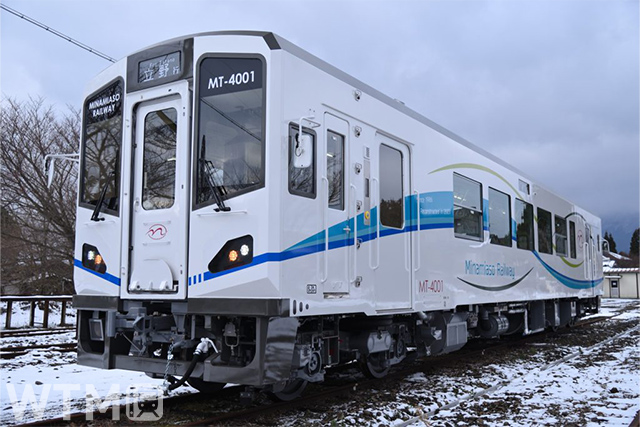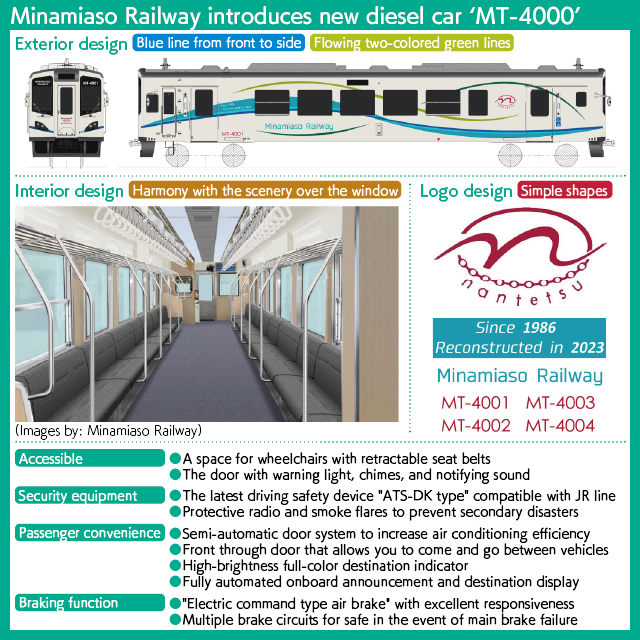Minamiaso Railway has introduced two new diesel trains, the MT-4000 series, with multilingual guidance and barrier-free access, ahead of the full line opening scheduled for the summer of 2023.

Expecting to accept inbound tourists
The Minamiaso Railway was not only a means of transportation for the local community, but also focused on tourism with the trolley train “Yusuge-go.” However, due to the Kumamoto earthquakes that occurred on April 14, 2016, the entire line was temporarily disrupted. A large amount of earth and sand flowed into the tracks, and tunnels and iron bridges were also severely damaged. As a result, the 10.5km section between Tateno and Nakamatsu out of a total of 17.7km is still inoperable.
Reconstruction donations and “railroad sleeper owners” were solicited from all over Japan, and in response to a large amount of support from fans who wanted to resume operation, construction for the full restoration of the line began in March 2018. With the aim of resuming operation on all lines in the summer of 2023, facility renovation work in the affected points is nearing its final stage.
After the opening of the entire line, the number of foreign tourists is expected to increase, so it was decided to introduce a new type of trains with the aim of improving the environment for receiving tourists.
The MT-4000 type is a general diesel railcar with both cabs manufactured by Niigata Transys (Headquarters: Seiro Town, Niigata), and was delivered to Minamiaso Railway in late November 2022. This is the first time in 25 years that Minamiaso Railway has introduced a new train since the MT-3010 (Type MT-3000) in 1998.
The exterior design is a completely new image from the existing trains, and the white-based body and lines that flow from the front to the sides are impressive. The blue line symbolizes the Shirakawa River that flows along the tracks and the pure water of springs such as Shirakawa Suigen. The green lines are an image of the five peaks of Aso seen from the train window, and the contrast between light and shadow is expressed in two lines with different colors.
In addition, the “n” logo on the front and sides of the train body is the initial letter of the Minamiaso Railway’s nickname, “Nantetsu.” At the same time, it also expresses the five peaks of Aso and the outer rim of the mountain that surrounds them. In addition, 10 small ovals linked together are drawn, symbolizing that the 10 stations from Tateno to Takamori have been restored and connected after the Kumamoto earthquakes. (Refer to the chart below for details such as the exterior, interior and logo mark design of the type MT-4000.)

Scheduled to run directly to the JR Hohi Line
All the seats in the train are long seats, and the colors of the seats and floor coverings are subdued in consideration of the magnificent scenery of Aso in front of the line of sight. The side walls and ceiling incorporate bright wood grain to create a sense of openness, creating a simple harmony throughout the vehicle.
In terms of services, the doors are semi-automatic to improve air-conditioning effects, and accessible facilities include a wheelchair space, ramps for getting on and off, and door chimes. Assuming the use of foreign tourists, it is equipped with a full-color LED destination display that can alternately display necessary information in multiple languages.
“The Minamiaso Railway Revitalization Council”, which consists of Kumamoto Prefecture, local governments, and Minamiaso Railway, has decided on a policy to directly connect JR Kyushu’s Hohi Line to Higo-Ozu Station via Tateno Station in line with the restoration of the entire line. The driving safety device used by the Minamiaso Railway is the “ATS-SN type”, but the MT-4000 type uses the “ATS-DK type”, which has higher functionality considering the direct operation with the JR line.
For the brakes, an “electrically commanded air brake” is used, which is more responsive than the automatic air brakes used in conventional train cars, and maintainability is also improved. In addition, it has multiple brake circuits, so even if the main brake fails, the train can be stopped safely.
Comprehensive tests and crew training will begin in late January 2023, in preparation for commercial operation. In addition, the rolling stocks delivery ceremony will be held after January.






